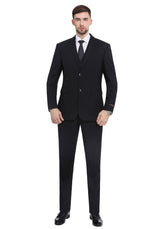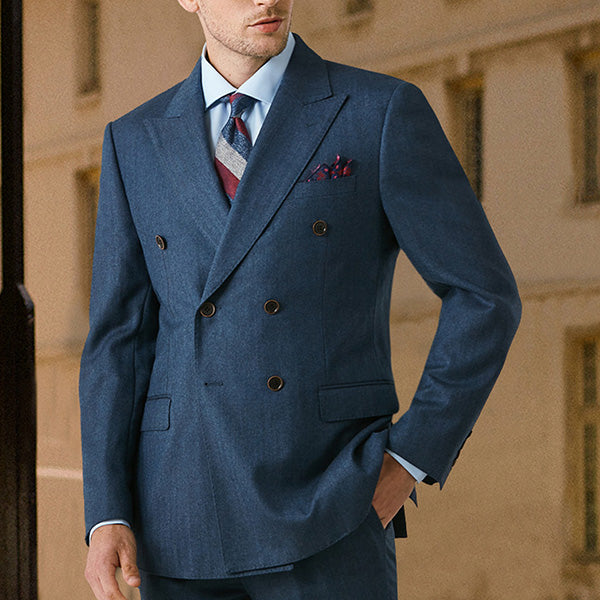20 Things to Consider When Buying a Suit
by
zhuping
21 Jun 2022
Whether you’re buying your first suit, your wedding suit, or a new bespoke suit ‘just because’, there’s a lot to consider. We know, we know…it can be daunting, especially if this is your first rodeo.
Luckily, here at P&L Men's Wear, we’re experts. Not just because of our experience in tailoring, but because we’ve helped hundreds of men create a made-to-measure suit that’s just right for them. From fit to style and everything in between (and believe us, there’s a lot in between) here are 20 things you should consider when buying a suit.
The Occasion
First things first, where are you planning on wearing your suit? Is this for everyday use? A special occasion? Is that occasion formal or informal? Are you planning for this to be your prom suit? Black Tie? White Tie? Do you have a job interview? Are you buying a new suit for a special presentation in front of your board of directors? We could keep going but we’ll stop there…
The point is, the occasion is important. It’ll dictate the general style of your suit (more on that later) including the accessories you choose.
Colour
Generally speaking, you have four options when it comes to colour: grey, blue, brown and black.
For an everyday suit, opt for grey or blue (navy, to be specific). Black tends to be more formal and brown, while dashing, can be difficult to pull off. We don’t want to dissuade you from brown, because it can look smart. But, done wrong, it can look tacky and outdated.
Of course, pastel suits, cream suits and burgundy suits are always an option, too…
The Season
The season will dictate the colour, style and fabric of your suit. In the summer, everything is more laid back and (obviously) hotter. This calls for something light-weight and lighter in colour. Pastels, remember? In the winter, you’re looking at much heavier suits in darker colours that you can match with the perfect wool overcoat. It’s all about practicality.
Of course, with a new season comes new trends. You may have noticed that designers come out with Spring/Summer and Autumn/Winter lines?
Fabric
When buying a suit, the fabric should be far from an afterthought. Do you want something lightweight and breathable? Thick and warm? Are you concerned about sweat stains?
While this isn’t exactly a definitive guide, here’s a quick run-down for you:
Wool Suits: Versatile and common and can even be found in a lightweight version called tropical wool.
Flannel Suits: Heavy, resistant to creasing and best suited for winter
Corduroy Suits: Durable, trendy and warm
Silk Suits: Trendy, incredibly lightweight but won’t hide perspiration
Linen Suits: Lightweight, comfortable but stains and creases easily
Tweed Suits: Thick, sturdy, warm and stylish
Cotton Suits: Breathable, absorbs moisture well, easy to care for
The Lapel
While we’ll be the first to admit that considerations 1-4 are quite broad and open-ended, we’re starting to get into the finer details now. For you, that means fewer options and hopefully an easier decision.
In terms of lapels, you’ve got notch lapels or peak lapels. That’s it! Just two!
A notch lapel is considered standard and is seen on most single-breasted suits and blazers. A peak lapel is considered more formal and is commonly found on double-breasted jackets and dinner suits.
If you’re creating a bespoke suit, why not stand out and add a peak lapel to a single-breasted blazer. This style was popular back in the Twenties and (as with all styles) it’s coming back ‘round!
Buttons
Again, we’re getting down to the nitty gritty here so you have fewer options.
One Button – One-button suit jackets tend to be reserved for more formal events. But, if you’re worried more about ashtethics than the occasion, the perk of a one-button jacket is that it creates a deeper V and shows off more of your shirt and tie.
Two Buttons – It’s classic and timeless. You really can’t go wrong here. While – yes – it has a higher stance than a one button jacket, your shirt and tie will still show through.
Three Buttons – This look is generally considered outdated and isn’t flattering on most body types.
Shoulder
Remember back in the 80’s when shoulder pads were big and bulky? Today, that’s what you don’t want.
The shoulder pad should lie flat and should end at your shoulder bone or slightly past it. It should meet the sleeve exactly where your arm meets your shoulder. If it meets below that, it’ll look lumpy and baggy, like you’re wearing your father’s suit. If it meets above that, not only will it look too small, but your range of motion will be terribly inhibited.
Sleeve Length
Ideally, your suit sleeve should end at, or just above, the wrist bone when your arm is at rest, showing about half an inch of your shirt (assuming it’s long-sleeved). It should never (ever) fall below the base of your thumb. If you have a look at the distance between your wrist and the base of your thumb, you’ll know that you don’t have much wiggle room.
It’s virtually impossible to find a suit jacket of
Luckily, here at P&L Men's Wear, we’re experts. Not just because of our experience in tailoring, but because we’ve helped hundreds of men create a made-to-measure suit that’s just right for them. From fit to style and everything in between (and believe us, there’s a lot in between) here are 20 things you should consider when buying a suit.
The Occasion
First things first, where are you planning on wearing your suit? Is this for everyday use? A special occasion? Is that occasion formal or informal? Are you planning for this to be your prom suit? Black Tie? White Tie? Do you have a job interview? Are you buying a new suit for a special presentation in front of your board of directors? We could keep going but we’ll stop there…
The point is, the occasion is important. It’ll dictate the general style of your suit (more on that later) including the accessories you choose.
Colour
Generally speaking, you have four options when it comes to colour: grey, blue, brown and black.
For an everyday suit, opt for grey or blue (navy, to be specific). Black tends to be more formal and brown, while dashing, can be difficult to pull off. We don’t want to dissuade you from brown, because it can look smart. But, done wrong, it can look tacky and outdated.
Of course, pastel suits, cream suits and burgundy suits are always an option, too…
The Season
The season will dictate the colour, style and fabric of your suit. In the summer, everything is more laid back and (obviously) hotter. This calls for something light-weight and lighter in colour. Pastels, remember? In the winter, you’re looking at much heavier suits in darker colours that you can match with the perfect wool overcoat. It’s all about practicality.
Of course, with a new season comes new trends. You may have noticed that designers come out with Spring/Summer and Autumn/Winter lines?
Fabric
When buying a suit, the fabric should be far from an afterthought. Do you want something lightweight and breathable? Thick and warm? Are you concerned about sweat stains?
While this isn’t exactly a definitive guide, here’s a quick run-down for you:
Wool Suits: Versatile and common and can even be found in a lightweight version called tropical wool.
Flannel Suits: Heavy, resistant to creasing and best suited for winter
Corduroy Suits: Durable, trendy and warm
Silk Suits: Trendy, incredibly lightweight but won’t hide perspiration
Linen Suits: Lightweight, comfortable but stains and creases easily
Tweed Suits: Thick, sturdy, warm and stylish
Cotton Suits: Breathable, absorbs moisture well, easy to care for
The Lapel
While we’ll be the first to admit that considerations 1-4 are quite broad and open-ended, we’re starting to get into the finer details now. For you, that means fewer options and hopefully an easier decision.
In terms of lapels, you’ve got notch lapels or peak lapels. That’s it! Just two!
A notch lapel is considered standard and is seen on most single-breasted suits and blazers. A peak lapel is considered more formal and is commonly found on double-breasted jackets and dinner suits.
If you’re creating a bespoke suit, why not stand out and add a peak lapel to a single-breasted blazer. This style was popular back in the Twenties and (as with all styles) it’s coming back ‘round!
Buttons
Again, we’re getting down to the nitty gritty here so you have fewer options.
One Button – One-button suit jackets tend to be reserved for more formal events. But, if you’re worried more about ashtethics than the occasion, the perk of a one-button jacket is that it creates a deeper V and shows off more of your shirt and tie.
Two Buttons – It’s classic and timeless. You really can’t go wrong here. While – yes – it has a higher stance than a one button jacket, your shirt and tie will still show through.
Three Buttons – This look is generally considered outdated and isn’t flattering on most body types.
Shoulder
Remember back in the 80’s when shoulder pads were big and bulky? Today, that’s what you don’t want.
The shoulder pad should lie flat and should end at your shoulder bone or slightly past it. It should meet the sleeve exactly where your arm meets your shoulder. If it meets below that, it’ll look lumpy and baggy, like you’re wearing your father’s suit. If it meets above that, not only will it look too small, but your range of motion will be terribly inhibited.
Sleeve Length
Ideally, your suit sleeve should end at, or just above, the wrist bone when your arm is at rest, showing about half an inch of your shirt (assuming it’s long-sleeved). It should never (ever) fall below the base of your thumb. If you have a look at the distance between your wrist and the base of your thumb, you’ll know that you don’t have much wiggle room.
It’s virtually impossible to find a suit jacket of
Tags:





